Author Blog: The Art of Silence

Graphic by Angelie Zaslavsky
Jay Neugeboren is the author of 20 books, including two prize winning novels, two prize-winning non-fiction books, and four collections of award-winning stories. His most recent books are “The American Sun & Wind Moving Picture Company” (March 2013) and “The Other Side of the World” (December 2012). His blog posts are featured on The Arty Semite courtesy of the Jewish Book Council and My Jewish Learning’s Author Blog Series. For more information on the series, please visit:
Although my novel, “The American Sun & Wind Moving Picture Company,” is set in the silent film era — it begins in 1915, in Fort Lee, New Jersey, where a Jewish family that makes one and two reel (silent) films is making a new film on a frozen lake — its origins may lie in the spoken word. When friends ask how and why I came to write a novel about the silent film era, the first answer that comes to mind is that the novel is inspired not by my love of film, but by my childhood love of listening to stories on the radio.
During my years in high school, in Brooklyn in the early ’50s, the New York City Board of Education’s radio station, WNYE-FM, regularly broadcast radio programs into elementary, junior high, and high school classrooms. And during those years I was a child/teenage actor at the radio station. I played some wonderful parts — Tom Sawyer, Hans Brinker, Willie the Whale, young Abe Lincoln, et al — and what the director of the station, Marjorie Knudsen, taught me on my first day there has stayed with me throughout my life. The most important element an actor has at his or her command for creating character, she said, were not words, but silence. The way you pause before a word, or between sentences, or after a particular phrase, or in the middle of a word — this, she said, is what makes listeners pay attention so that they can, in their imaginations, transform what they hear — and do not hear — into credible characters and scenes. The mystery of character — and the essence of what made listeners want to know what-happens-next, lay in those moments when there was no sound.
Here, then, from the first page of “The American Sun & Wind Moving Picture Company,” Joey Levine, a boy who plays both male and female parts in his family’s movies, and who conjures up the stories that his family turns into movies:
I could make a story out of anything back then — a nail, a glass, a shoe, a tree, a mirror, a button, a window, a wall — and for every story I made up and gave away, I also made one up that I told no one about — one I stored inside me, in the rooms where I kept my most precious memories and pictures.
What Joey is doing, I now realize (I didn’t see or understand this when I was writing the novel, which is told in his voice), is trying to conjure up the seen from the unseen — just as, when listening to the radio as a boy, I conjured up live human beings I could see in my mind’s eye, and to some degree like viewers of silent movies, who had to infer the unseen — the mysteries and complexities of character — from the seen. Viewers, that is, had to infer thoughts and feelings, not from words characters spoke (though there were often titles between scenes where snatches of dialogue were projected onto the screen), but from expressions and gestures the characters made — from closeups of eyes, for example — that told of those silent, inner worlds that were un-seen. In both radio dramas, and silent films, the greatest source of mystery and power — of our attachment and interest in fictional characters — resided in ways to make us sense what we could not see, whether what we saw came to us in images or in sound.
In “The American Sun & Wind Moving Picture Company,” Joey is forced into exile, and we follow his cross-country adventures in both time and space — from New Jersey to Wisconsin to California, and from 1915 to 1930. He arrives in Los Angeles at a time when silent movies are giving way to “talkies” and where his uncle Karl, who directed the family’s movies when Joey was a boy, has become a major producer and director in Hollywood. In the novel’s final chapter, Joey and Joey and Karl sit on a mountain top and look down at a desert that has been the setting for a great battle the day before for the uncle’s cast-of-thouands production of Solomon and the Queen of Sheba. And what do these two men do when they look down upon a scene of horrific devastation? It is the end of the Sabbath, and they talk about the sermon they heard in synagogue that morning — they talk about King David and King Solomon, and about God’s ways, and about why it is the rabbis say that on the day the Temple was destroyed, the Messiah was born.
Visit Jay Neugeboren’s official website here.
The Jewish Book Council is a not-for-profit organization devoted to the reading, writing and publishing of Jewish literature. For more Jewish literary blog posts, reviews of Jewish books and book club resources, and to learn about awards and conferences, please visit www.jewishbookcouncil.org.
MyJewishLearning.com is the leading transdenominational website of Jewish information and education. Visit My Jewish Learning for thousands of articles on Judaism, Jewish holidays, Jewish history and more.
















